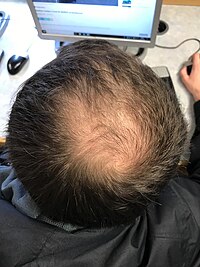
Photo from wikipedia
The majority of patients with Parkinson’s disease (PD) develop sleep disturbances, which are among the most troublesome nonmotor symptoms of the disease. These sleep disturbances include, but are not limited… Click to show full abstract
The majority of patients with Parkinson’s disease (PD) develop sleep disturbances, which are among the most troublesome nonmotor symptoms of the disease. These sleep disturbances include, but are not limited to, disrupted circadian rhythm, insomnia, excessive daytime sleepiness, and rapid eye movement sleep behavior disorder (RBD), with increased motor activity during rapid eye movement sleep. They may occur early, even in the preclinical phase of PD, and can dominate the clinical picture in advanced stages. However, the exact molecular mechanisms underlying these sleep defects remain poorly understood, and effective therapeutic options are limited. Currently, patients are managed symptomatically with melatonin or traditional dopamine replacement therapy, which is effective only in a subset of patients. Moreover, dopaminergic medication has been shown to induce sleep-wake disruption in PD patients, stressing the importance of parallel, nondopaminergic systems. To develop novel therapeutics addressing these sleep pattern defects and to increase knowledge about the underlying mechanisms, animal models provide a useful tool. Several Drosophila PD models have been created and validated, including those with loss of the PD-associated proteins PTENinduced kinase 1 (PINK1) and Parkin. Both models show locomotion and mitochondrial defects and loss of dopaminergic neurons corresponding to clinical, pathological, and pathophysiological observations in patients carrying PTEN-induced kinase 1 or Parkin mutations. However, it should be noted that data on sleep disturbances in Parkin and PTEN-induced kinase 1 mutation carriers are scarce with specific information on this particular symptom available for only 6.4% (66/1931) of all described patients (www.mdsgene.org). Nevertheless, sleep pattern defects such as insomnia, daytime sleepiness, and rapid eye movement sleep behavior disorder have been observed in patients with Parkin mutations, supporting the notion that monogenic forms of PD recapitulate clinical findings in idiopathic PD and can thus serve as a model. In an attempt to resolve the mechanisms responsible for the sleep pattern defects in PD, Valadas and colleagues use PTEN-induced kinase 1 and Parkin Drosophila models. Importantly, they find sleep pattern defects similar to those observed in patients, including increased motor activity during sleep periods and defective circadian rhythm that manifests as reduced morning and evening anticipation. Furthermore, they highlight the involvement of neuropeptidergic neurons in these sleep pattern defects via a mechanism of increased endoplasmic reticulum (ER)-mitochondrial contact sites that had previously been observed in PD. The ER donates membranes to the secretory vesicles, which contain neuropeptides required for a proper sleep pattern. Increased ER-mitochondrial contact sites lead to a defective ER-lipid balance as a result of abnormal lipid trafficking and the subsequent depletion of the lipid phosphatidylserine at the ER in neurons. As a result, secretory vesicle formation is prevented and followed by disruption of the release of sleep-controlling neuropeptides. Using Construct helping in mitochondria-ER association (ChiMERA) transgenic flies to provoke ER-mitochondrial contact sites, the authors showed that increased contact sites are sufficient to induce sleep pattern defects. Interestingly, they demonstrate that phosphatidylserine supplementation recovers the ER-lipid imbalance and increases secretory vesicle production, resulting in the elevated release of sleep-pattern-controlling neuropeptides in the Drosophila PD models. Notably, they confirmed the identified molecular mechanisms in patientderived induced-pluripotent stem cell (iPSC)-derived hypothalamic neurons, showing the evolutionary conservation of the underlying mechanisms in the observed sleep pattern defects. Valadas and colleagues provide the following novel and translationally important insights: (1) neuropeptidergic neurons are defined as a nondopaminergic system responsible for sleep pattern defects in PD, (2) imbalance of the lipid phosphatidylserine at the ER inhibits the release of sleep-controlling neuropeptides by preventing the formation of secretory vesicles in these neuropeptidergic neurons, (3) although determination of safe and effective doses of phosphatidylserine in patients is essential and will require a clinical trial, pharmacological rescue of a ER-lipid imbalance suggests a novel therapeutic strategy to improve sleep pattern defects in PD.
Journal Title: Movement Disorders
Year Published: 2018
Link to full text (if available)
Share on Social Media: Sign Up to like & get
recommendations!